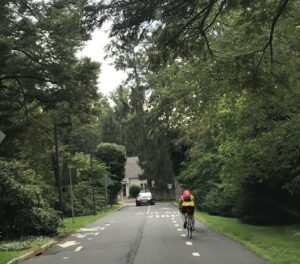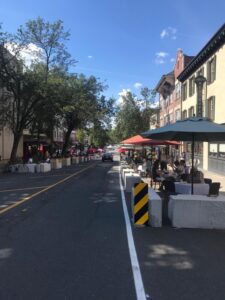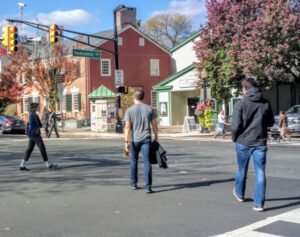 Getting around town has been evolving over the past 18 months, and more changes are coming. With the pandemic and the stay-at-home order, there were fewer drivers, and those empty roads became welcome places for walking, running, skating, skateboarding, and biking for physical and mental health benefits, and just for fun. During this time, you might have found new places to explore, known someone who has learned to ride or skate, or discovered a bike that came out of hiding after years in the garage.
Getting around town has been evolving over the past 18 months, and more changes are coming. With the pandemic and the stay-at-home order, there were fewer drivers, and those empty roads became welcome places for walking, running, skating, skateboarding, and biking for physical and mental health benefits, and just for fun. During this time, you might have found new places to explore, known someone who has learned to ride or skate, or discovered a bike that came out of hiding after years in the garage.
Our bike stores have remained very busy places, keeping pace with the demand. Even today new bikes will be sold as soon as they arrive, and some spare parts continue to be backordered. This is not just locally – bikes are in high demand nationally and globally.
Add to this scene the popularity of e-scooters, e-bikes, e-skateboards, and you get the picture of multi-faceted active transportation in our town that will increase noticeably when students return to schools and campuses for in-class teaching next month.
Another way to get around town that’s making a comeback this month is the successor to the FreeB! Initially the bus service will run a continuous 30-minute loop Monday through Friday, mornings and afternoons. Over the next few months, the Municipality will be gathering feedback in order to develop a long-term solution to our public transit needs.
 Meanwhile our restaurants, shops, and other activities have been adapting too. In order to increase their ability to serve customers, our local businesses have been permitted to expand outdoors. On-street parking spaces have given way to café seating, parklets, and streateries. Again, this is not a local phenomenon – it has happened across the country and around the world.
Meanwhile our restaurants, shops, and other activities have been adapting too. In order to increase their ability to serve customers, our local businesses have been permitted to expand outdoors. On-street parking spaces have given way to café seating, parklets, and streateries. Again, this is not a local phenomenon – it has happened across the country and around the world.
Parking is a hot topic nationwide. A balance is being sought amongst those needing general parking availability, 30-minute spots, and loading zones, those who do not own a car or wish to leave their cars at home to reach downtown safely by foot or on a bike, and those looking for outdoor commercial and public use. For each person who arrives downtown on foot, by bike, or by public transit, that’s one more parking space that hasn’t been occupied.
In Princeton there has been a consultant’s study on parking that analyzed supply and demand issues, and how to better manage the parking we have. However, it did not address how parking relates to alternative transportation in our community, and other activities that want their own piece of the public right-of-way. These concerns are likely to come to the fore as we plan for the future.
The shift to expanded outdoor commercial space coincided with the municipality’s plans to make considerable infrastructure improvements along the length of Witherspoon Street. This kind of road reconstruction work is performed about every 30 years or so, and plans were already underway before the pandemic hit. Looking 30 years ahead gives the town’s engineering and planning professionals the opportunity to anticipate the needs of residents and businesses through 2050.
The first phase of the Witherspoon project has focused on the segment from Nassau Street to Green Street. Witherspoon’s parklets, café seating on the sidewalks, and streateries in parking spaces and loading zones have been well received by Princeton’s residents and visitors. It should be noted that expanding to the sidewalk and the street has caused traffic on Witherspoon Street to be narrowed to one lane. Plans are moving ahead to make these changes on the first phase of Witherspoon permanent.
 Princeton’s Pedestrian & Bicycle Advisory Committee (PBAC) aims to make walking, biking, and rolling safer and accessible for people of all abilities, and I chair the committee. I am very proud of the PBAC members whose efforts have been recognized as the New Jersey Bike & Walk Coalition’s 2021 Advocate of the Year, and by the League of American Bicyclists who named Princeton as a Silver Bike Friendly Community in 2020.
Princeton’s Pedestrian & Bicycle Advisory Committee (PBAC) aims to make walking, biking, and rolling safer and accessible for people of all abilities, and I chair the committee. I am very proud of the PBAC members whose efforts have been recognized as the New Jersey Bike & Walk Coalition’s 2021 Advocate of the Year, and by the League of American Bicyclists who named Princeton as a Silver Bike Friendly Community in 2020.
Two of PBAC’s primary resource documents are available online: Princeton’s Bicycle Mobility Plan and Sidewalk Plan. Wherever there’s a road reconstruction project PBAC looks for implementation of the Bike Mobility and Sidewalk Plans. PBAC also review plans for new construction projects, with a focus on the safety of people walking and biking on the nearby streets and sidewalks and making recommendations to be considered in the building plans.
PBAC has reviewed the Witherspoon Street Redesign-Phase 1, and in the near future will provide feedback on plans to improve the safety of the intersection of Rosedale Road and General Johnson Drive – the entrance to Johnson Park School. This work is being funded through a Safe Routes to School grant.
 There are many interesting trails and loop routes to ride in Princeton, and the recently updated Princeton Bicycle Map shows them in detail (for a paper copy, contact us at the email address below). One of the most popular routes is the Bike Boulevard loop that follows low-volume, low speed roads that connect the four Princeton elementary schools and create a loop about 10-miles long.
There are many interesting trails and loop routes to ride in Princeton, and the recently updated Princeton Bicycle Map shows them in detail (for a paper copy, contact us at the email address below). One of the most popular routes is the Bike Boulevard loop that follows low-volume, low speed roads that connect the four Princeton elementary schools and create a loop about 10-miles long.
Safe Routes to School is a nationwide program to educate children about how to be safe walking and biking from Kindergarten through 8th grade. The municipality, our four elementary schools, and the middle school have all been strong participants in this program and are recognized as either Gold or Silver level.
As we enjoy being outdoors, and more of us consider walking and biking to get around town in place of driving, we need to find ways to share this public space and respect each other’s needs. As employees, students, and customers return to businesses, schools, and many other activities, there will be more vehicles on our roads.
Roads and streets are the public domain, just like parks. How we apportion the use of them is basic arithmetic. How much of that space is dedicated to sidewalks, cafes, car lanes, parking, loading bays, and bike lanes depends on how to share it amongst the many legitimate demands on this scarce resource.
When planning for the next 20 to 30 years, will we each be driving our private vehicle in 2050? Many transportation professionals do not think so. There’s also the consideration of what our vehicles are contributing to climate change, and the effects that our children and grandchildren will inherit.
PBAC’s monthly meetings are open to the public and posted on the municipal website. You can also reach us by email to share your interests and concerns at pjpbac@gmail.com.

Lisa Serieyssol is Chair of Princeton’s Pedestrian & Bicycle Advisory Committee and leads a team in advancing bike and pedestrian infrastructure, awareness, and education. She works at Greater Mercer TMA as an active transportation practitioner to create safe networks on roads and trails for cyclists and pedestrians across New Jersey.
